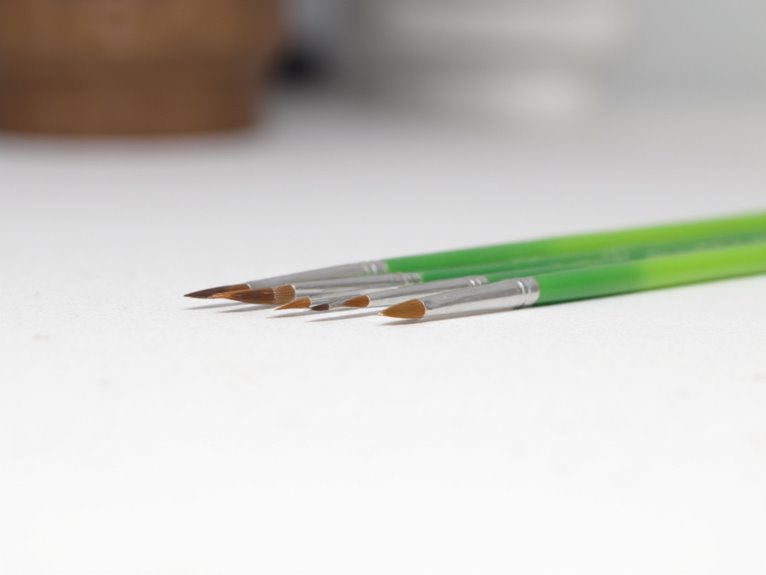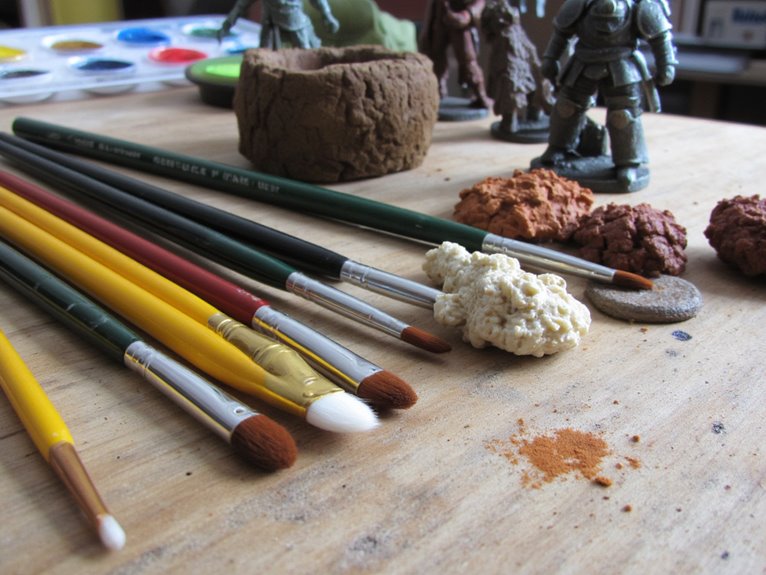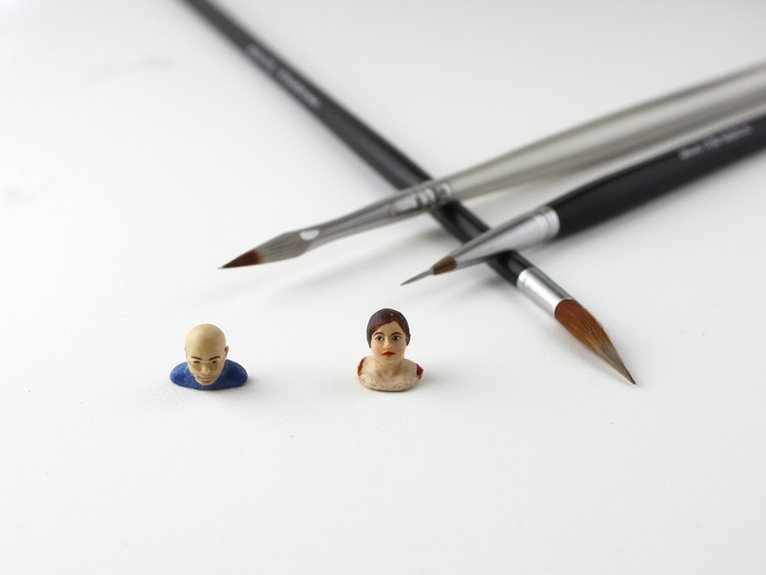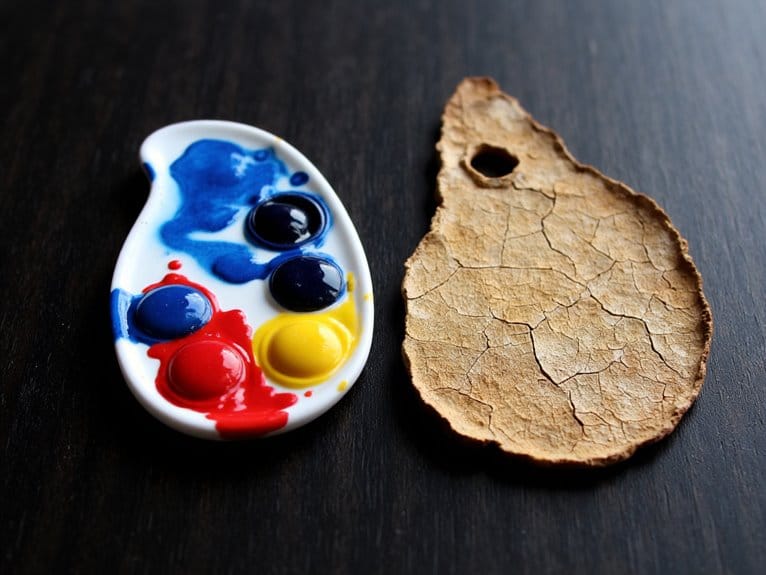We are supported by our audience. When you purchase through links on our site, we may earn an affiliate commission, at no extra cost for you. Learn more. Last update on 1st July 2025 / Images from Amazon Product Advertising API.
You’ll need three essential brush sizes for most miniature painting: size 0 for precise details like eyes and weapon highlights, size 1 as your primary workhorse for general painting and layering, and size 2 for efficient base coating of larger areas. These correspond to bristle lengths of 8-10mm, 10-12mm, and 12-14mm respectively. Round brushes work best for detail work, while flat brushes excel at broader coverage and dry brushing techniques. Understanding these fundamentals will markedly improve your painting precision and efficiency.
Notable Insights
- Size 0 brushes are ideal for fine details like eyes and teeth with 8-10mm bristle length.
- Size 1 serves as a versatile workhorse brush for general painting and highlighting with 10-12mm bristles.
- Size 2 brushes work best for base coating and covering larger areas with 12-14mm bristle length.
- Sizes 6 and 13 are recommended specifically for effective dry brushing techniques on miniatures.
- Specialty detail brushes range from 20/0 to 00 for precise work on intricate miniature features.
Understanding Brush Size Numbers and Measurements
Understanding brush sizes represents one of the most confusing aspects of miniature painting, yet it’s essential to selecting the right tool for each task. Brush size numbering ranges from extremely small (20/0 or 0000) to large (24+), with smaller numbers indicating finer detail brushes. Numbers with zeros designate brushes smaller than size 0, primarily used for ultra-precise work.
Round brushes use numeric sizing, while flat brushes are measured by actual bristle width in fractions like 1/8″ or 1/4″. This creates measurement discrepancies when comparing different brush types.
No universal standard exists between manufacturers, meaning a size 6 from one brand differs physically from another’s size 6. Visual inspection becomes vital since numeric labels serve as rough guides rather than exact specifications. For general miniature painting, size 2 serves as an excellent all-around brush that provides versatility for most painting tasks. For dry brushing techniques, sizes #6 and #13 are particularly effective for weathering effects and broad coverage applications. Starting from size 8, the incremental changes typically jump by 2 rather than increasing one at a time.
Optimal Size Range for Miniature Work

Three specific brush sizes form the foundation of any effective miniature painting toolkit: sizes 0, 1, and 2. This combination provides complete coverage for standard miniature painting tasks without unnecessary overlap or gaps in capability.
Size comparison reveals distinct advantages for each brush. Size 1 serves as your workhorse, balancing precision with paint capacity for most applications. Size 0 delivers superior detail work through its sharper tip, while size 2 handles broader coverage efficiently.
| Brush Size | Primary Use | Bristle Length |
|---|---|---|
| Size 0 | Fine details, eyes, teeth | 8-10mm |
| Size 1 | General painting, highlighting | 10-12mm |
| Size 2 | Base coating, large areas | 12-14mm |
Brush length specifications confirm proper spring and control across different painting phases. This three-brush system eliminates inefficient practices like using tiny brushes for large areas. Premium synthetic nylon bristles in these sizes provide excellent durability and paint retention for miniature work. Brush names indicate intended use and help painters select the appropriate tool for each specific painting task. The pointed round shape maximizes efficiency across all three sizes for consistent miniature painting results.
Brush Shape Selection for Detail and Precision
While size determines your brush’s capacity and coverage area, shape controls how that paint reaches the miniature’s surface. Round brushes with pointed tips excel at fine detail work like eyes, buckles, and armor patterns. Size 2 rounds handle base coating and layering efficiently. Size 1 provides precision for edge highlighting without sacrificing control. Size 0 tackles extremely fine details.
Flat brushes cover large areas quickly but lack precision for intricate work. Filbert brushes combine round and flat qualities, offering versatility for both broad strokes and moderate detail work.
Brush thickness impact varies greatly between shapes—round brushes concentrate paint flow through narrow tips while flats distribute it broadly. Bristle material choices affect performance: synthetic bristles maintain sharp points longer, while natural bristles hold more paint but may lose precision faster. Ergonomic triangular handles reduce hand fatigue during extended painting sessions and provide better grip control. Natural hair brushes like sable offer superior paint retention compared to their synthetic counterparts. Premium brushes feature a large belly design that enhances their carrying capacity while maintaining precision.
Essential Starter Set Recommendations
When starting your miniature painting journey, you’ll need a core trio of brushes: size 2 for base coating and broad work, size 1 for mid-range details and edge highlighting, and size 0 for fine features like eyes and small ornaments.
Beyond this foundation, consider adding specialty brushes such as a dedicated drybrush for texture effects and a regiment brush that holds large paint volumes while maintaining a precise tip.
Your initial investment should prioritize high-quality synthetic fibers over quantity, as three well-made brushes will outperform a dozen cheap alternatives in both performance and longevity. Look for brushes with triangular precision grips that provide better control and comfort during extended painting sessions.
Core Brush Trio
Essential starter brush sets center around a carefully selected trio that addresses every fundamental miniature painting task.
You’ll need a size 1 standard round brush for base coating, a size 0 detail brush for precision work, and a dedicated drybrush for texture effects. This combination covers preparation, precision, and finishing phases without redundancy.
The brush material greatly impacts performance. Synthetic fibers provide excellent durability and paint retention, making them ideal for beginners. Natural sable brushes offer superior paint flow but require more careful maintenance.
Handle design matters equally—triangular or ergonomic grips reduce hand fatigue during extended painting sessions.
Each brush serves distinct functions. Your base coat brush applies uniform primer layers.
The detail brush handles intricate features like eyes and insignia. The drybrush creates weathering effects on raised surfaces.
Specialty Brush Additions
| Brush Type | Primary Use | Size Range |
|---|---|---|
| Detail Brushes | Eyes, pupils, fine features | Size 0, 00, 000 |
| Dry Brushes | Weathering, texture highlights | Various sizes, stiff bristles |
| Vehicle/Scenery | Large surfaces, terrain work | Size 4+, flat shapes |
Size 0 brushes excel at extremely fine detailing techniques like facial expressions and small embellishments. Dry brushes feature stiffer bristles designed for highlighting raised surfaces and creating weathered effects. Vehicle brushes use wider, firmer bristles for medium coverage on larger models. Starter sets like the “Mega Brush Set” include nine diverse brushes covering these specialty applications, enabling you to explore advanced techniques as your skills develop.
Quality Investment Guidelines
Three essential brush sizes form the foundation of any miniature painting starter set: size 2, size 1, and size 0 or 00. Your budget considerations should prioritize quality over quantity when starting out. A size 2 brush handles base coating and larger details efficiently.
Size 1 brushes excel at fine highlighting and edge work. Size 0 or 00 brushes tackle intricate details like eyes and small embellishments.
When conducting brand comparisons, high-quality synthetic fibers offer the best value for beginners. They provide excellent durability and paint retention without the premium cost of Kolinsky sable.
Synthetic alternatives have improved dramatically, delivering professional results at accessible prices. Investing in three quality brushes performs better than purchasing multiple cheap options that deteriorate quickly, making this approach more economical long-term.
Matching Brush Size to Painting Technique

When selecting brushes for miniature painting, your technique determines the ideal brush size more than any other factor. Fine detail work requires sizes 20/0 to 00 for precise lines and intricate features like eyes and teeth. These technique varieties demand extreme precision that only the smallest brush types can deliver.
Fine detail work demands the smallest brushes—sizes 20/0 to 00—for achieving the extreme precision that intricate miniature features require.
Size 2 brushes excel at base coating and layering, striking the perfect balance between coverage and control. They handle paint volume efficiently while maintaining detail capability.
For broader coverage, sizes 6-10 work well for blending, though size 1-2 remains best-suited for miniatures.
Large brushes (sizes 12-24) serve specific purposes: rapid base coating of vehicles, terrain, and backgrounds. Round pointed brushes offer versatility across multiple techniques, while flat brushes excel at broad strokes and dry brushing textures. Specialized dry brushes with goat hair provide enhanced texture capabilities for achieving realistic weathering and highlighting effects on miniature surfaces.
Quality Factors That Impact Performance

While technique determines brush size selection, the quality of your brush fundamentally affects every aspect of your painting performance. Superior bristle materials directly impact paint flow, tip retention, and stroke precision on your miniatures.
Kolinsky sable bristles offer the highest performance standard. These natural fibers from Siberian weasels hold more paint than synthetic alternatives while maintaining sharp points longer.
You’ll achieve finer detail work with less frequent reloading compared to synthetic brushes, which require smaller sizes to match natural bristle sharpness.
Quality factors that maximize your painting efficiency include:
- Bristle composition – Natural hair provides superior paint holding capacity and flexibility
- Handle ergonomics – Proper diameter and weight distribution reduce hand fatigue during extended sessions
- Tip durability – High-grade brushes maintain points through hundreds of cleaning cycles
Investment in quality brushes pays dividends through improved control and longevity. High-quality nylon bristles with flagged tips also provide excellent paint absorption and elasticity for miniature work while offering anti-shedding properties that maintain consistent performance.
Proper Care to Maintain Brush Effectiveness

Your brush’s performance directly depends on how well you maintain it through proper cleaning and storage practices.
Even the highest-quality kolinsky sable brush will lose its point and develop splayed bristles within weeks if you don’t follow basic care protocols.
These maintenance techniques can extend your brush’s effective lifespan from months to several years while preserving the precision control essential for miniature detail work.
Cleaning and Storage Methods
Three fundamental practices will determine whether your miniature brushes maintain their precision for years or deteriorate within months: proper cleaning, correct drying, and protective storage.
Effective cleaning techniques require immediate action after each painting session. Rinse brushes with warm water, then work brush soap gently into bristles using your fingers. Pay special attention to the ferrule area where paint accumulates and hardens.
- Air dry brushes horizontally or bristles-down to prevent water from entering the ferrule and loosening glue.
- Store brushes upright in containers or horizontally in protective cases to prevent bristle bending and crushing.
- Use brush guards or protective caps to maintain pointed shapes essential for detail work.
Smart storage solutions protect your investment. Keep brushes separated to prevent tangling, store them in clean, dry locations away from heat sources, and never leave them soaking in water containers.
On a final note
You’ll achieve the best miniature painting results by starting with sizes 0, 2, and 00 brushes in your core kit. Match brush diameter to your detail requirements—use 00 for fine lines and 2 for base coats. Kolinsky sable brushes offer superior paint retention and tip precision compared to synthetic alternatives. Maintain your brushes with proper cleaning and storage to preserve their performance. Your technique improvement depends more on consistent practice than expensive brush collections.


